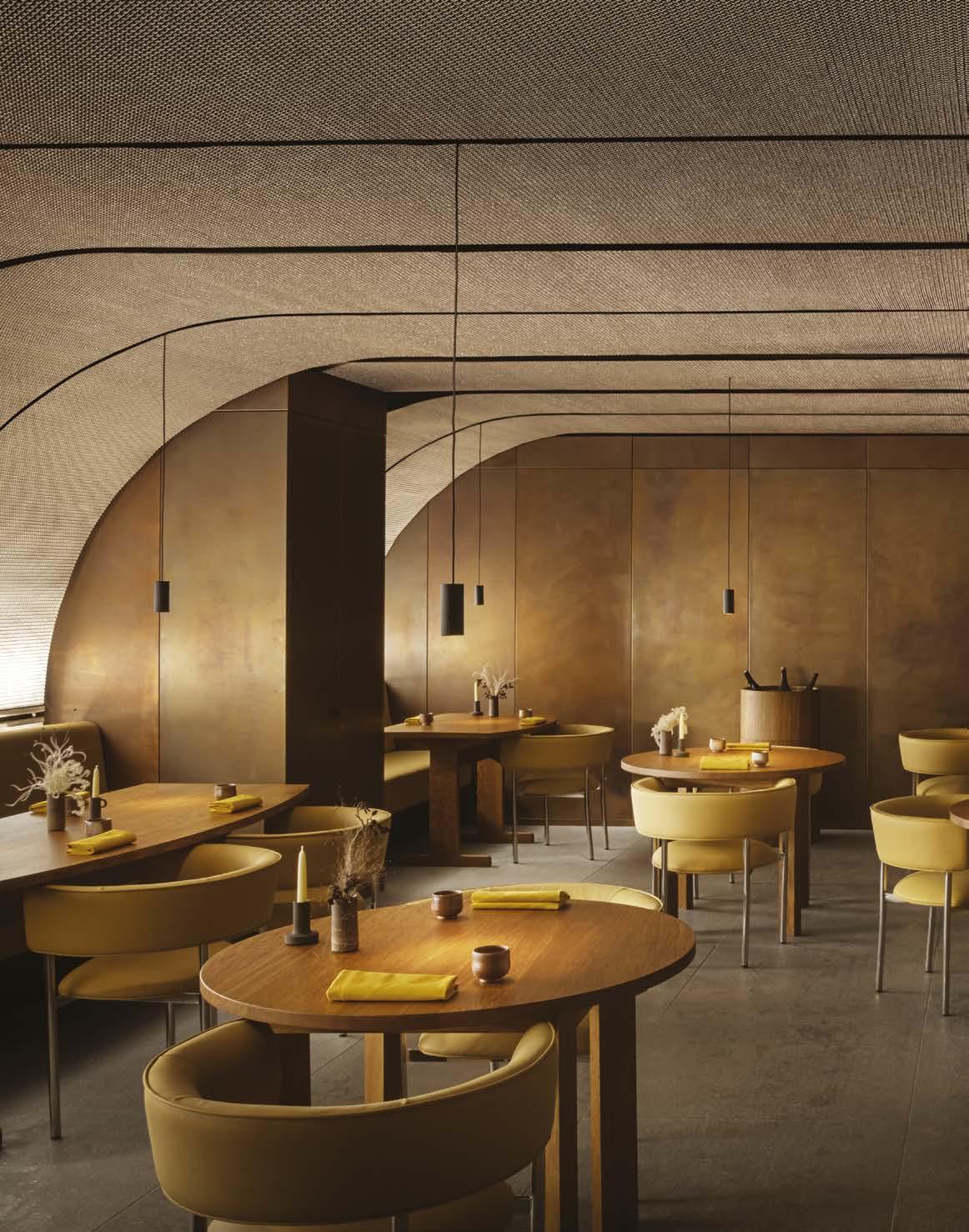
4 minute read
IKOYI RESTAURANT
David Thulstrup
A LONDRA, LA NUOVA SEDE DEL RISTORANTE STELLATO MIXA
Advertisement
L’ARCHITETTURA BRUTALISTA INGLESE CON IL DESIGN DANESE.
MENTRE IN CUCINA IL GUSTO BRITANNICO SI SPOSA CON I SAPORI DELL’AFRICA OCCIDENTALE
IN LONDON, THE NEW HEADQUARTERS OF THE STARRED RESTAURANT
MIX ENGLISH BRUTALIST ARCHITECTURE WITH DANISH DESIGN.
WHILE IN THE KITCHEN THE BRITISH TASTE IS COMBINED WITH THE FLAVORS OF WEST AFRICA
QUI : La sala ristorante è calda e accogliente grazie a un originale mix di materiali: dal rame alla pietra, dalla rete d’acciaio alla pelle, al legno.
HERE: The dining room is warm and cosy thanks to the unique mix of materials: from copper to stone, from steel mesh to leather, to wood.


DALL’ALTO, IN SENSO ORARIO: Il guardaroba; una rete inox riveste i soffitti e le pareti; attraverso un’ampia vetrata i tavoli si affacciano su un piccolo, quieto giardino.
FROM ABOVE, CLOCKWISE: The wardrobe; a stainless steel mesh covers the ceilings and walls; through a wide glass window the tables overlook onto a small, quiet garden.
Occupano l’interno di un iconico edificio brutalista londinese degli anni Settanta nel quartiere di St James’s Market, a due passi dalla centralissima Regent Street, i nuovi spazi di Ikoyi, celebre ristorante due stelle Michelin. A progettarli è stato l’architetto danese David Thulstrup, firma nota nel campo dell’ospitalità e della ristorazione (suo anche il design del Noma, uno dei più famosi ristoranti stellati al mondo). La sfida, per Thulstrup, era trovare una formula originale per sposare il suo bakground nordico, e quindi la semplicità di uno stile sempre accogliente e inclusivo, con il genius loci di questo angolo di Londra, un luogo unico per storia e architettura. “Si trattava di allineare il carattere rude e grezzo dell’edifico scelto come sede del nuovo ristorante, con un progetto d’interni che fosse capace di restituire confort, calore e intimità”, spiega il progettista. “Ma bisognava anche enfatizzare l’originale offerta culinaria dello Ikoyi, a metà strada fra i sapori stagionali britannici e le spezie intense dell’Africa Occidentale”. Ispirato da questo incontro tra culture diverse, l’architetto danese ha sviluppato un progetto d’interiors che punta sulla particolarità dei materiali e sull’artigianalità della loro lavorazione.

Così, preziose lastre di rame ossidato e rifinite con cera d’api, rivestono le pareti interne della sala da pranzo, mentre lastre extra-large di calcare catalano, fiammate e spazzola - te, disegnano una griglia perfetta sui pavimenti. A sorpresa, una rete inox riveste con morbide volte i soffitti e le pareti, facendo da schermo alle finestre. I rivestimenti di pelle color zenzero delle banquette, delle sedie e dei pannelli delle pareti creano un equilibrato contrasto cromatico con il rovere locale usato per i tavoli su misura e i mobili da incasso. Inox spazzolato, infine, come rivestimento scelto per la cucina e l’area d’accesso che dà sulla sala da pranzo.


IN BASSO, IN SENSO ORARIO: Nell’area reception rivestita da lastre in rame ossidato spiccano tre maxi frigoriferi con ante in vetro illuminate; la cucina e il corridoio aperto sull’area pranzo sono realizzati in acciaio inox spazzolato.
BELOW, ON THE CLOCKWAY: Three maxi refrigerators with illuminated glass doors stand out in the reception area clad in oxidized copper plates; the kitchen and the corridor open to the dining area are finished in brushed stainless steel.


IN ALTO: Un angolo del ristorante, arredato con divanetto e tavolo rotondo destinato a più commensali.
A SINISTRA E IN BASSO: Due piatti dal menu del ristorante che mixa il gusto britannico con i sapori dell’Africa Occidentale.


ABOVE: A corner of the restaurant, furnished with a sofa and a round table for several diners.

LEFT AND BELOW: Two dishes from the restaurant’s menu, which mixes British taste with West African flavours.
Insomma, come sottolinea l’architetto danese, “Ikoyi è un ristorante ricco di esperienze sensoriali, dove gli elementi di design si fondono perfettamente con l’artigianalità e la cura di ciò che viene servito nel piatto”. H
The new spaces of Ikoyi, the famous two-Michelin-star restaurant, occupy the interior of an iconic 1970s London brutalist building in the St James’s Market district, a stone’s throw from Regent Street. They were designed by the Danish architect David Thulstrup, well-known in the field of hospitality and catering (he also signed Noma, one of the most famous starred restaurants in the world). The challenge for Thulstrup was finding an original formula to marry its Nordic background, and therefore the simplicity of a style that is always welcoming and inclusive, with the genius loci of this corner of London, a unique place for its history and architecture. “It was a question of aligning the rough and raw character of the building chosen as the location for the new restaurant, with an interior design that was capable of restoring comfort, warmth and intimacy,” explains the designer. “But we also had to emphasize Ikoyi’s original culinary offering, somewhere between British seasonal flavors and the intense spices of West Africa.”
Inspired by this encounter between different cultures, the Danish architect has developed an interior design project that focuses on the particularity of the materials and the craftsmanship of their processing.
Thus, precious slabs of oxidized copper finished with beeswax cover the interior walls of the dining room, while extra-large slabs of Catalan limestone, flamed and brushed, draw a perfect grid on the floors. Surprisingly, a steel mesh covers the ceilings and walls with soft vaults, acting as a screen for the windows. The ginger leather upholstery of the banquettes, chairs and wall paneling creates a balanced colour contrast with the local oak used for the bespoke tables and built-in furniture. Lastly, brushed stainless steel has been chosen as the coating for the kitchen and the access area that opens onto the dining room. In short, as the Danish architect points out, “Ikoyi is a restaurant full of sensory experiences, where design elements blend perfectly with the craftsmanship and attention to what is served on the plate”. H










